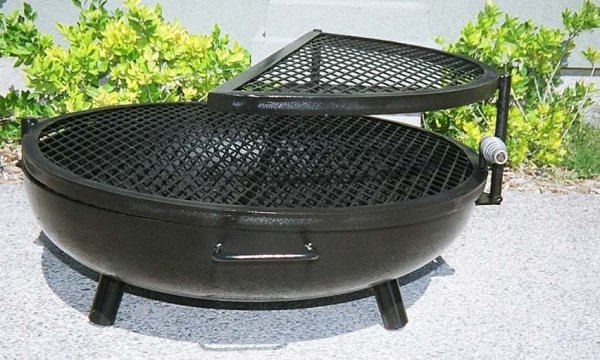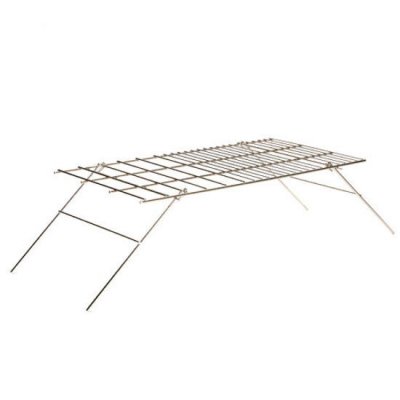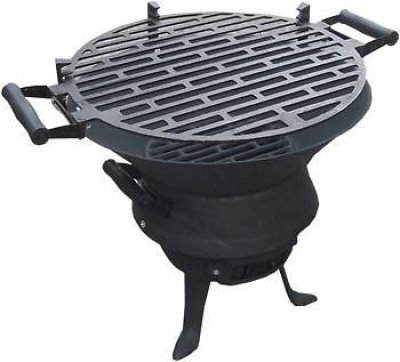Note to the thrifty owner: DIY barbecue grill

For cooking delicious grilled dishes outdoors, a barbecue grill is an indispensable assistant. But provided it is compliance with stated preferences.
To understand which option is the most suitable and whether you can take matters into your own hands, you need to find out the advantages and disadvantages of all popular types of gratings.
Purpose of the barbecue grill
A barbecue grate (grill grate) is a device used to cook various food products over an open fire or in a specially designed oven.

Photo 1: Some barbecue grates have legs to allow them to be placed over the coals.
The use of gratings has a whole a number of advantages:
- food is being prepared without using oil, which has a positive effect on health;
- on her convenient to place several types of food at once;
- in the process it's easy control the degree of roasting;
- the design itself does not take up much space;
- does not require any additional devices.
Important! When cooking over an open fire, observe safety precautions: wear protective gloves, control the fire intensity, avoid contact with flammable objects.
Barbecue grates are divided into several types. Each of them has its own advantages and disadvantages, having analyzed which it will be easy to decide on the appropriate option.
Selecting mesh material
Considering that today there are many different interpretations on the topic of barbecue (grill, electric grill, gas barbecue oven, etc.), it is worth clarifying that we are talking about grates suitable for use in conventional garden ovens.
Nickel
This is the most popular choice. They are made of steel coated with a thin layer of nickel. They come with one working surface or with two folding ones that are fixed together with a clamp.

Main advantages:
- Price. This is the most budget option available on the market.
- Variety of shapes and sizes. The same manufacturing technology is used for the non-standard form factor, but the source material is thicker - steel rods of a larger diameter. This gives the barbecue grill the necessary rigidity.
- Prevalence. Such grilles are sold in absolutely any store, and it will not be difficult to buy one even at the very last moment on the way to a picnic.
Main flaws:
- Weak fixation of rods. This problem is especially common with small grills. If handled carelessly, the wire starts to slide in different directions, and compact products fall into the fire.
- Short-lived. After just a few uses, the coating will peel off and stick to your food. If you continue using the grill after that, it will rust.
To keep the product fit for work longer, it is necessary careful care: timely cleaning of the mesh with a special brush, sanding of chipped areas with sandpaper and drying in the open air.
Cast iron
This material is virtually "indestructible", which makes it ideal on many counts:

- He does not oxidizeThis means that rust will never touch it.
- Careful attitude to products. Companies that have put production on stream cover finished products with a special composition, which prevents sticking and burning food to the grate. Like the famous "thinking about us" frying pans.
- DurabilityAfter many years of use, this material will become boring rather than deteriorate.
- Fixed hole diameterThe grill does not deform under pressure or heat, and food pieces will not fall through the holes.
- Wide range of sizes. Finding the right option for your stove is not a problem.
Possible flaws:
- The first and foremost is price. Cast iron barbecue grates are significantly more expensive than their counterparts in the shop. This, of course, is fully compensated by durability, but not many are ready to immediately pay such a sum.
- Uniformity of forms. Most often, it is a rectangle or a circle. If there is a need for a non-standard shape, it is better to look for something else.
Maintenance of such a grille It couldn't be simpler: it can be cleaned in any convenient way - both wet and dry. No special storage conditions are required either.
Stainless steel
Not the most common choice for making a grate, but it has weight. advantages:

- Uniqueness of shape and size. If you expect frequent use for non-standard shapes, then this is the most suitable option. You won't have to look for a replacement anytime soon.
- DurabilityStainless steel is a material that is very resistant to high temperatures and does not deform over time.
- Optimal rigidityThe rods perfectly maintain their original position, without squeezing the products excessively (given the moderate load).
Cons in use:
- Burning food. Since the material is not coated with any non-stick compound, there is a chance that food will stick to the grate during cooking.
- PriceIt is not as expensive as cast iron, but it is not a “drop in and buy” option. It is something that is bought consciously for many years.
- Inaccessibility. You won't often find such a product in stores, so many people prefer to make them themselves.
Even though there are food particles left on the rods after cooking, to look after behind the grille is very easy. All the carbon deposits are cleaned off under a stream of water with a special brush and dried well.
How to do everything yourself?
If you want to make a barbecue grill yourself, then the best option for this is stainless steel. Of all the available materials, it is the easiest to obtain and work with. It can be made into absolutely any shape and size that will fit the existing stove.
Important! Argon is best for welding stainless steel, so if you have it, feel free to get started.
Stages process:
- From a sheet of stainless steel of a suitable size, stepping back about three cm, cut out the middle part.
- Between the outer and inner border draw a dividing line.
- For the main part, take wire from the same material with a diameter about 3-5 mm.
- Trim the rods to such a length that, crossing the hole, they reach the drawn line.
- Weld the ends in this place. There is no need to weld the rods together at the points of contact!
- Make cuts at the corners of the frame and wrap it up free edges inward, pressing tightly against the rods themselves and into the voids. This will protect against cuts.
- Distribution frequency Use the wires at your discretion. But make sure that pieces of food do not fall into the holes.
- Availability pens — not always necessary. If you need it, make it from a thick rod, attaching a wooden holder to the end. The length of the handle should not exceed the width of the grate itself, otherwise the balance will be disturbed.
- If you really want to, you can deviate from the canons and weld the rodsthe gratings are not standard diamonds, but snake or some other weaving.
Homemade grates are also made from cast iron, but this method is rarely practiced due to the technically complex process. Welding requires very precise observance of temperature conditions and the use of special electrodes. At the slightest deviation from the norms, the cast iron structure begins to collapse. For simple amateurs and beginners this method is absolutely does not fit.

Photo 2. Argon welding with a consumable electrode is used when working with stainless steel and aluminum.
Possible problems
The most common mistakes when making gratings yourself, the following are:
- application too low-melting materials;
- soldering the contact point rods, which reduces the mobility of the structure and increases unnecessary pressure on the products;
- use as a base very labor-intensive metals.
Avoid these mistakes, and the result of your painstaking work will bring only positive emotions.
A well-made and carefully thought-out version of a do-it-yourself barbecue grill will not only fully meet the desired parameters, but will also become a real a reason to be proud.
Useful video
Check out the video, which shows step by step how to make a grill grate yourself.







And I made the gratings from ordinary stainless steel. The neighbor made a fence, or rather a pen for cattle.
Very strong stainless steel, although not thick. I sawed it into rods and welded it. This one is just for the time being. I haven't found where to get a cast iron grate yet.